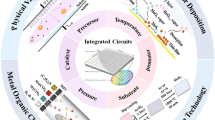Abstract
This paper presents a new fabrication process of through glass via (TGV) substrate, which combines glass and silicon into a single wafer. By using double sided glass in silicon reflow process with a patterned silicon mold, a thick and robust TGV substrate which is difficult or timewasting to realize by single side glass reflow process could be achieved. The fabrication process and parameters are studied in details. Surfacing roughness of the TGV substrate after polishing is measured to be 3.421 nm, showing a high surface quality for anodic bonding process. Resistance of vertical feedthroughs are measured in the range of 180 to 260 Ω, indicating that the substrate can be used in a large variety of application. Finally, strength tests of the bonding interface are measured to be as high as 7.28 MPa, indicating a mechanically strong bonding.








Similar content being viewed by others
References
M.M. Torunbalci, S.E. Alper, T. Akin, Wafer level hermetic sealing of MEMS devices with vertical feedthroughs using anodic bonding. Sens. Actuators A 224, 169–176 (2015)
M.M. Torunbalci, S.E. Alper, T. Akin, A method for wafer level hermetic packaging of SOI-MEMS devices with embedded vertical feedthroughs using advanced MEMS process, J. Micromech. Microeng. 25, 125030 (2015)
M.M. Torunbalci, S.E. Alper, T. Akin, Advanced MEMS process for wafer level hermetic encapsulation of MEMS devices using SOI cap wafers with vertical feedthroughs. J. Microelectromech. Syst. 24, 556–564 (2015)
I. Savidis, S.M. Alam, A. Jain, S. Pozder, R.E. Jones, R. Chatterjee, Electrical modeling and characterization of through-silicon vias (TSVs) for 3-D integrated circuits. Microelectron. J. 41, 9–16 (2010)
C.-T. Ko, Z.-C. Hsiao, Y.-J. Chang, P.-S. Chen, Y.-J. Hwang, H.-C. Fu et al., A wafer-level three-dimensional integration scheme with Cu TSVs based on microbump/adhesive hybrid bonding for three-dimensional memory application. IEEE Trans. Device Mater. Reliab. 12, 209–216 (2012)
J.H. Lee, H.J. Kim, J.-Y. Song, C.W. Lee, T.H. Ha, IEEE, “A study on wafer level TSV build-up integration method,” in 2013 IEEE International 3rd Systems Integration Conference, 2013
S. Ogawa, S. Soda, S.-S. Lee, S. Izuo, Y. Yoshida, RF-MEMS switch with through-silicon via by the molten solder ejection method. Sens. Actuators A Phys. 181, 77–80 (2012)
S. Shi, X. Wang, C. Xu, J. Yuan, J. Fang, S. Liu, Simulation and fabrication of two Cu TSV electroplating methods for wafer-level 3D integrated circuits packaging. Sens. Actuators A Phys. 203, 52–61 (2013)
Z. Wang, 3-D integration and through-silicon vias in MEMS and microsensors. J. Microelectromech. Syst. 24, 1211–1244 (2015)
J.-Y. Lee, S.-W. Lee, S.-K. Lee, and J.-H. Park, Through-glass copper via using the glass reflow and seedless electroplating processes for wafer-level RF MEMS packaging, J. Micromech. Microeng. 23, 085012 (2013)
L. Hofmann, R. Ecke, S.E. Schulz, T. Gessner, Investigations regarding through silicon via filling for 3D integration by periodic pulse reverse plating with and without additives. Microelectron. Eng. 88, 705–708 (2011)
S.-W. Lee, S.-K. Lee, and J.-H. Park, High-density through-wafer copper via array in insulating glass mold using reflow process, Jpn. J. Appl. Phys. 54, 047202 (2015)
A. Benali, M. Faqir, M. Bouya, A. Benabdellah, M. Ghogho, Analytical and finite element modeling of through glass via thermal stress. Microelectron. Eng. 151, 12–18 (2016)
A. Benali, M. Bouya, M. Faqir, A. El Amrani, M. Ghogho, A. Benali et al., “Through glass via thermomechanical analysis: geometrical parameters effect on thermal stress,” in 2013 8th International Design and Test Symposium (Idt), 2013
J.-H. Chien, H. Yu, C.-L. Lung, H.-C. Chang, N.-Y. Tsai, Y.-F. Chou et al., “Thermal stress aware design for stacking IC with through glass via,” in 2012 7th International Microsystems, Packaging, Assembly and Circuits Technology Conference, ed, 2012
S. Cho, V. Sundaram, R.R. Tummala, Y.K. Joshi, Impact of copper through-package vias on thermal performance of glass interposers. IEEE Trans. Compon. Packag. Manuf. Technol. 5, 1075–1084 (2015)
R.M. Haque, K.D. Wise, A glass-in-silicon reflow process for three-dimensional microsystems. J. Microelectromech. Syst. 22, 1470–1477 (2013)
I.-J. Hyeon, C.-W. Baek, Micromachined substrate integrated waveguides with electroplated copper vias in reflowed glass substrate for millimeter-wave applications. Microelectron. Eng. 131, 19–23 (2015)
C.-W. Lin, C.-P. Hsu, H.-A. Yang, W. C. Wang, W. Fang, “Implementation of silicon-on-glass MEMS devices with embedded through-wafer silicon vias using the glass reflow process for wafer-level packaging and 3D chip integration,” J. Micromech. Microeng. 18 (2008)
Y. Sun, D. Yu, R. He, F. Dai, X. Sun, L. Wan, “The development of low cost through glass via (TGV) interposer using additive method for via filling,” in 2012 13th International Conference on Electronic Packaging Technology and High Density Packaging (Icept-Hdp 2012), pp. 49–51, 2012
Y. Zhu, B. Chen, D. Gao, M. Qin, Q. Huang, J. Huang, A robust and low-power 2-D thermal wind sensor based on a glass-in-silicon reflow process, Microsyst. Technol. 22, 1–12 (2015)
Acknowledgements
This work was supported by the National Natural Science Foundation of China (NSFC, Grant No. 51505490) and carried out at the Microsystem Laboratory, College of Mechatronics and Automation, National University of Defense Technology.
Author information
Authors and Affiliations
Corresponding author
Rights and permissions
About this article
Cite this article
Li, W., Xiao, D., Wu, X. et al. A new fabrication process of TGV substrate with silicon vertical feedthroughs using double sided glass in silicon reflow process. J Mater Sci: Mater Electron 28, 3917–3923 (2017). https://doi.org/10.1007/s10854-016-6005-0
Received:
Accepted:
Published:
Issue Date:
DOI: https://doi.org/10.1007/s10854-016-6005-0




